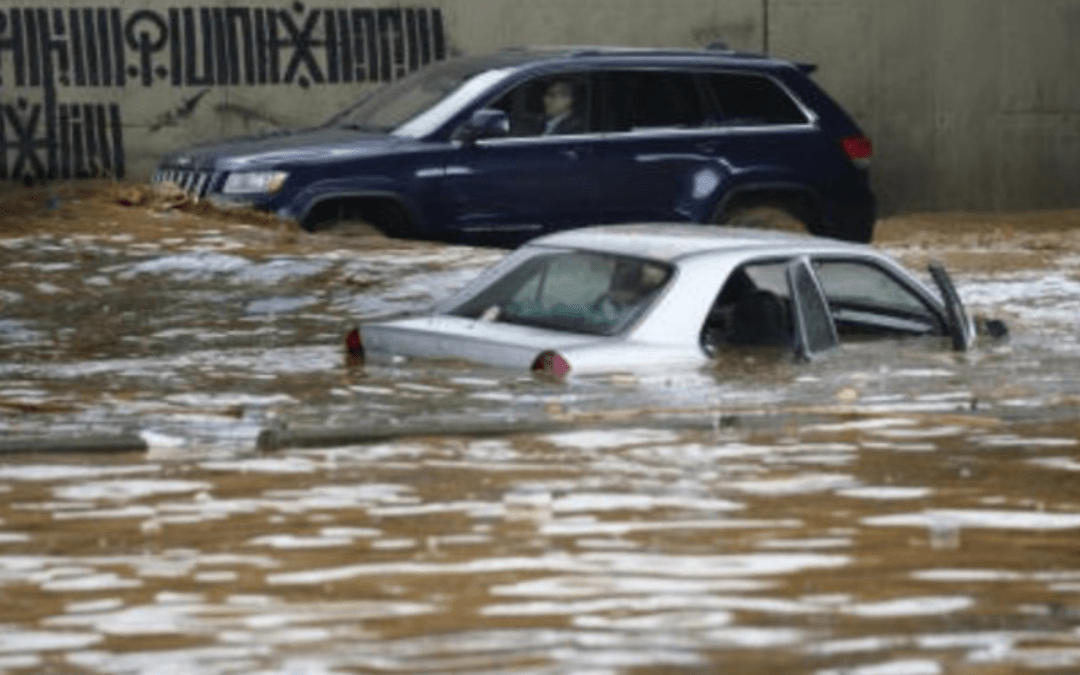By Laetithia Harb | Staff Writer
With a lack of maintenance of the Lebanese territories, infrastructural issues are meant to come up.
Every time it rains or changes regarding the weather occur around Lebanon, roads become inaccessible and if accessible, unsafe to the people. For the past couple of years, with every winter season, roads flood up and put citizens’ lives and homes in danger.
Lebanon is known for its rainy weather, where rain falls heavily and in very short periods making it hard for the sewage systems to work properly, especially with the lack of cleaning and upkeep. With each winter, people’s cars and homes are directly adversely affected as the roads are destined to flood with an infrastructure unable to sustain itself and with poor to no maintenance.
In response to the most recent flood of the roads, the caretaker Minister of Public Works Ali Hamieh blames the yellow sand from constructions stuck in the sewers, he said, “Some people wonder why water collects on highways and not in drains. A video from a sewer in Dbayeh shows huge quantities of construction sand being removed by a machine belonging to the ministry.”
Not only did people’s homes get affected by the floods taking place around Lebanon, but refugees living in tents in camps have also been severely affected, leaving hundreds of them even more vulnerable without any secure place to house them.
A refugee from the Akkar region has been quoted saying, “Our tents are soaked in water, we barely managed to escape during the floods and have no home anymore, we are staying with our families.”
Alongside the floods, some roads are breaking apart, whereas some are blocked due to landslides and a lack of wall reinforcements. The deteriorating conditions of the Lebanese underground infrastructure and sewage system are creating a safety hazard that is compromising the lives of millions of people while placing additional pressure on the government and hindering the economy.
For instance, Dahr el Baydar, an international highway connecting the Bekaa Valley to Beirut, has had to restrict vehicle crossings, especially cargo trucks, because of the collapse of the fortifying walls that keep the roads’ base protected. Thus, passers can now see the road split on the side with smaller passageways to the cars.
Pierre Hajj, a taxi driver who crosses Dahr el Baydar highway on a daily basis said, “This road is not at all safe, they have these signs up as if they will make any difference, but the truth is, if the government doesn’t find any solution soon, the roads will only get worse. Who knows, it might even fall apart altogether.”
However, Hamieh thinks there might be a solution to all these infrastructural issues: maintenance.
But, for this plan to occur, the ministry needs more funds than are not available at the moment. According to Hamieh, more than 100 million dollars are needed, which is an amount the ministry is incapable of handling. He even asked Lebanon’s “friends” for support.
Hamieh insists that solutions will be found, money will be provided, and roads, especially Dahr el Baydar, will be fixed. He said, “We have begun addressing this issue to ensure the safety of citizens and to prevent further soil erosion. We need to channel all water drains into one path and have instructed the reinforcement of the incident site to avoid further slides.”
However, in a statement on Jan 21st, Hamieh announced that all Lebanese roads are a means of danger, he announced, “If the ministry’s budget for 2024 is less than 350 million dollars, we will be seeing plenty of roads collapsing with no means of servicing.”
This brings us back to the fact that all the consecutive governments haven’t allocated proper resources to the maintenance and betterment of the Lebanese infrastructure since 2019. With the pent-up issues having accumulated over the last couple of years, it is becoming increasingly more expensive and harder to maintain Lebanese roads.
Studies show that weather is only a small factor behind the dangers of driving in Lebanon. A study done by experts at Global Positioning Specialists (GPS), looked into 60, most car-dependent countries around the world to identify the most dangerous countries for drivers.
The criteria GPS investigated were the quality of the roads, the number of road deaths, and the vehicle theft rates. Based on that, each country was assigned a score based on its national statistics; high road death and crime rates meant lower scores.
Lebanon made it to the top of the list with a high road traffic death rate of 22.6 deaths per 100,000 population and extremely poor road quality conditions.
Lebanon has been rendered a country with dangerous roads and life-threatening driving conditions, making finding a solution for safer routes an issue that ought to be on the top of the political agenda. The question remains, will the political class be able to reach a enough consensus and amass enough political will to act upon the matter, or will the Lebanese nation need to witness yet another calamity before the government’s inaction begins to wither?
Sources:
https://www.lbcgroup.tv/news/lebanon-news/747500/environment-minister-to-lbci-damages-caused-by-rainfall-will-be-assess/en
https://today.lorientlejour.com/article/1364281/drivers-trapped-refugee-camps-evacuated-as-storm-floods-lebanon.html
https://www.alhurra.com/lebanon/2024/01/13/%D8%A7%D9%84%D8%A3%D9%85%D8%B7%D8%A7%D8%B1-%D8%A7%D9%84%D8%BA%D8%B2%D9%8A%D8%B1%D8%A9-%D8%AA%D8%BA%D8%B1%D9%82-%D8%B7%D8%B1%D9%82%D8%A7%D8%AA-%D9%84%D8%A8%D9%86%D8%A7%D9%86-%D9%88%D9%85%D8%AE%D9%8A%D9%85%D8%A7%D8%AA-%D9%84%D9%84%D8%A7%D8%AC%D8%A6%D9%8A%D9%86-%D8%A7%D9%84%D8%B3%D9%88%D8%B1%D9%8A%D9%8A%D9%86?amp
https://www.lbcgroup.tv/news/lebanon-news/747552/caretaker-minister-ali-hamieh-inspects-site-of-landslide-in-dahr-al-ba/en
https://www.mtv.com.lb/en/news/local/1417974/hamieh-addresses-dahr-el-baydar-soil-collapse–prioritizes-emergency-measures-for-road-safety
https://www.mtv.com.lb/en/news/local/1417110/photos–lebanon-tops-list-of-most-dangerous-countries-to-be-a-driver

